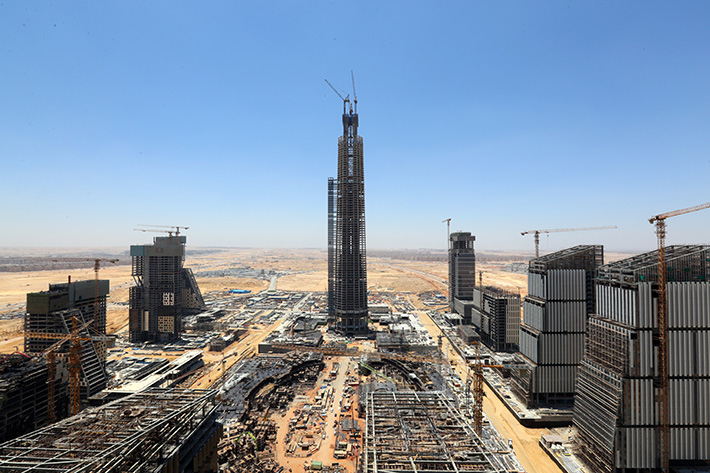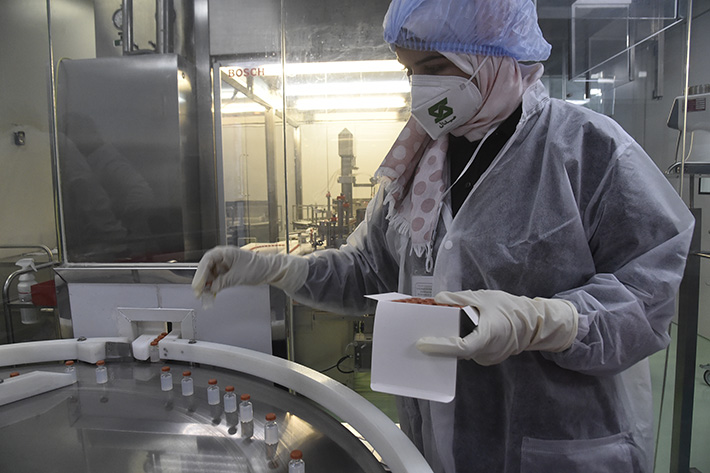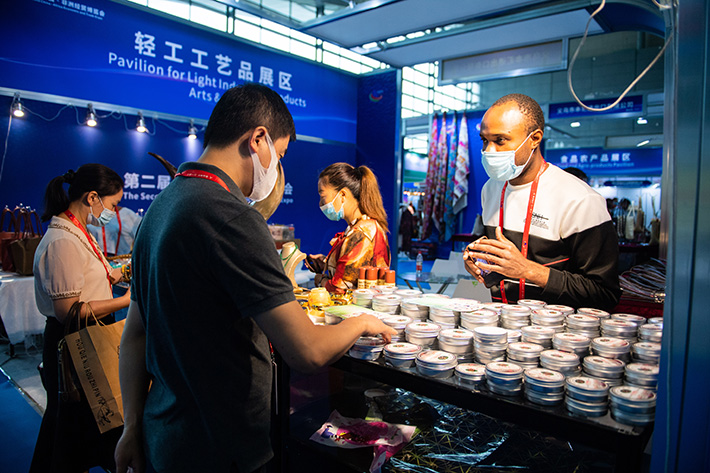|
||||||||||
| Home Nation World Business Opinion Lifestyle ChinAfrica Multimedia Columnists Documents Special Reports |
|
||||||||||
| Home Nation World Business Opinion Lifestyle ChinAfrica Multimedia Columnists Documents Special Reports |
| Current Cover Story |
| China has fulfilled its commitments under the FOCAC framework |
| Despite the devastating effects of COVID-19 on the global economy and mobility of the people around the world, China has still done its best to carry on the implementation of the plans. |
| By Hu Fan VOL. 13 NOVEMBER 2021 ·2021-10-29 |

The Iconic Tower under construction in Egypt's new administrative capital on June 17 (XINHUA)
The Beijing Summit of the Forum on China-Africa Cooperation (FOCAC) in 2018 outlined the plans for China-Africa cooperation in the following three years. Despite the devastating effects of COVID-19 on the global economy and mobility of the people around the world, China has still done its best to carry on the implementation of the plans.
One recent example is the Second China-Africa Economic and Trade Expo (CAETE) held on September 26-29 in Changsha, central China’s Hunan Province. It is an important measure to implement the Eight Major Initiatives proposed at the 2018 FOCAC Summit. Scheduled at a time when many African exhibitors were unable to show up in person due to travel restrictions, the expo stepped up efforts, including holding meetings and exhibitions online, to ensure maximum participation and effect of the event. In the end, the expo saw the signing of 135 programs worth $22.9 billion, a better outcome than what was achieved at the first expo in 2019 before the COVID-19 pandemic.
Efforts like this have contributed to a quick recovery and development of China-Africa cooperation, as suggested by data. The trade volume between the two sides reached $139.1 billion in the first seven months of this year, a year-on-year increase of 40.5 percent and a new record for this period of any year, revealed Qian Keming, Vice Minister of Commerce of China, at a press conference in September.
According to him, despite the pandemic, China’s direct investment in Africa increased by around $3 billion in 2020 compared to 2019. “This shows the confidence of Chinese companies in the African market and the vitality of China-Africa trade and economic cooperation,” Qian noted.

A staff member of pharmaceutical firm Saidal checks COVID-19 vaccines produced in a joint venture with Sinovac in Constantine, Algeria, on September 29 (XINHUA)
Resilient bond
Since the outbreak of the COVID-19 pandemic, China-Africa cooperation in health care, which was one of the Eight Major Initiatives proposed at the Beijing FOCAC summit, has intensified. From the shipment of anti-pandemic supplies and exchange of anti-pandemic experience to the dispatching of medical expert teams, China doubled down on its commitments as the pandemic spread. The focus has now shifted to the availability of vaccines to African countries.
One effective way to make more vaccines available in Africa is to cooperate with African countries to produce vaccines locally. On May 21, Chinese firm Sinovac’s first batch of raw materials for producing COVID-19 vaccines arrived in Cairo, Egypt, where they would then be processed into vaccines by a local firm. Egyptian Ambassador to China Mohamed El Badry told ChinAfrica that the program provided vaccines not only to Egypt, but also to the rest of Africa.
On September 29, Algeria became the second African country to produce Chinese vaccines locally as its joint vaccine facility with Sinovac was put into operation in the city of Constantine.
The commitment to build the Africa Center for Disease Control and Prevention headquarters, a key aid program under the FOCAC health care initiative, has also been fulfilled. On December 14, 2020, the construction of the project was kicked off in Addis Ababa, Ethiopia. Covering a land of over 90,000 square meters and containing modern office space, high-end laboratories and other facilities, the building will shore up Africa’s ability to cope with diseases.
In terms of infrastructure, despite the inconveniences and concerns caused by the pandemic, many Chinese workers have stayed on duty with their local colleagues at projects under construction in Africa.
One such project is the Central Business District being built in Egypt’s new administrative capital, about 45 km east of Cairo. Launched in 2016, the mega-project covering an area of 505,000 square meters is being built as scheduled by China State Construction Engineering Corp. in collaboration with their Egyptian partners. On the busiest days, over 9,000 workers were on site for the project.
Liu Jingkun, a Chinese engineer, was among them. He joined the project in 2019 to work as a safety supervisor. He had to carry a heavy burden after the pandemic hit Egypt in February 2020, but he never complained as he understood the significance of the work he was doing. “The project is one of the Belt and Road projects and we have to make sure it is built as scheduled,” he said.
In August this year, the last steel beam was placed on the Iconic Tower, one of the 20 tall buildings of the project, marking the completion of the steel skeleton of the would-be tallest skyscraper in Africa.
China has also taken steps to reduce the trade imbalance. One important approach is to diversify the imports from Africa to include more variety of goods, such as agricultural products. This year has witnessed the arrival of the first shipment of African dry chili pepper from Rwanda as part of a 50,000-ton deal. At the CAETE that concluded in September, a campaign was launched to promote 100 African brands to increase the exposure of African products in the Chinese market.
In terms of promoting connectivity, there is also a new milestone. On October 7, 86 containers of rice transported from Zhuzhou in Hunan Province to the Guangzhou Port in Guangdong Province by train were shipped to the Port of Mombasa in Kenya. This marked the first shipment via the Hunan-Guangdong-Africa route that combines railway and maritime transportation. As an innovation in the China-Africa logistics system, the route constitutes an important channel for the flow of goods between inland China and Africa.

An exhibitor promotes shea butter products at the second CAETE in Changsha, Hunan Province, on September 27 (XINHUA)
Wider involvement
China-Africa cooperation has continuously expanded since the launch of FOCAC in 2000. In terms of trade, for example, the volume grew from 87.37 billion yuan ($13.58 billion) in 2000 to 1.3 trillion yuan ($202 billion) in 2020, with an average annual growth of 14.5 percent, according to China’s General Administration of Customs.
During the period, the China-Africa cooperation has also broadened to include more players other than state-owned businesses. Customs data show that China’s private sector accounted for 60.2 percent of the country’s total trade with Africa in 2020, compared to 5.4 percent in 2000, and the amount of its trade with Africa increased from 4.76 billion yuan ($0.74 billion) in 2000 to 783.09 billion yuan ($121.69 billion) in 2020, with an average annual growth of 29.1 percent.
Private companies also account for a larger share of investment in Africa. According to the Report on Chinese Investment in Africa released on August 26 as the result of a research program led by China’s Ministry of Foreign Affairs, private investment accounts for 70 percent of all Chinese direct investment in Africa by the end of 2020.
The report said these companies, which are more market-driven, are generally optimistic about the African market and have reached a stage where they are making long-term plans for their operations on the continent. In addition to traditional areas, these companies are also interested in new sectors such as high-end manufacturing, medicine, digital economy and aviation.
Among them are smartphone producer Transsion and e-commerce platform Kilimall. The African market has proven to be another land of opportunity for them besides China where competition is fierce in their respective sectors.
In the case of Transsion, it has been Africa’s number one smartphone seller for years and is now expanding its business to developing apps such as music streaming media Boomplay, news app Scooper and short video app Vskit. “It is the right time to engage in the mobile Internet industry in Africa,” said Qiu Yusheng, Managing Director of Transsion’s investment department, at a forum held in Hunan during the CAETE.
The China-Africa cooperation has also seen more active involvement in China at the local level. In Hunan Province, the local government launched the Pilot Zone for In-depth China-Africa Economic and Trade Cooperation in September 2020, as part of its plan to build a pilot free trade zone in the province.
In Zhejiang Province, one of China’s most active provinces in China-Africa cooperation, one of the recent measures was the launch of a trading hub in Kigali, Rwanda, in July 2020 to facilitate the flow of goods between Rwanda and Zhejiang’s Yiwu, which is the world’s capital of small commodities.
China’s intent to promote China-Africa cooperation can be best illustrated by how a China-Africa joint venture in the Democratic Republic of the Congo helped five local companies exhibit their products at the CAETE. Knowing that these companies wanted to take part but were unable to send people to China due to the pandemic, SICOMINES, a joint venture in the mining industry between two Chinese companies with investment from local entities, volunteered to help.
It formed a work group to help these companies with customs clearance and shipment of their samples to China. Staff members of its Beijing office were sent to the expo to set up a booth, print promotional materials and introduce the products to visitors. This allowed these companies to participate in the expo without having to be on the site.
As FOCAC prepares for its next meetings, it will find a solid foundation on which it can plan for the next three years and beyond. This will allow it to aim higher for the future China-Africa cooperation and serve as a strong booster for the development of both China and Africa in the pandemic era.
(Print Edition Title: Delivering On the Promise)
Comments to hufan@chinafrica.cn
| About Us | Contact Us | Advertise with Us | Subscribe |
| Copyright Beijing Review All rights reserved 京ICP备08005356号-5 京公网安备110102005860号 |